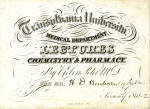Robert Peter, M.D. (1805-1894)
Click image to enlarge
Of good southern English stock and related to the Bathurst Peters, Robert Peter, born January 21, 1805, future scientist and eager student of research, came over from Cornwall when twelve years old with his parents, Robert and Johanna. Six other children came with them and the family settled first in Baltimore, then in Pittsburgh, Pennsylvania, where the children soon had to make each a share of the family expenses.
Robert went into a drug store and developed a bent for chemistry and medicine, eventually graduating M. D. from Transylvania University in 1834. But after practicing for a while in Lexington, he turned his attention wholly to natural sciences, and, being a real amateur (lover), was able as a lecturer and writer to arouse the enthusiasm of his students. His chemical work while on the Kentucky Geological Survey made him known as a delicate and exact analyst and he acquired a local reputation as a toxicologist. When on a summer tour in England in 1839, with his friend, Dr. O. J. M. Bush, he energetically collected books and apparatus for his class teaching and came home the proud owner of a Daguerre photographic outfit—the first in the West. Doubtless his wife, Frances Paca. daughter of Maj. William Dallam, whom he had married four years previously, and his children, Johanna and Alfred, had their "likenesses" taken in every possible position.
After this return he also experimented with the then novel guncotton and with pyroxyline; electricity also gaining his delighted attention. He had an ear always alert for new ideas, a trait strikingly displayed even in old age, and would sweep cheerfully aside his most cherished theories when they were shaded by dawning scientific facts. This energetic physician and L>r. C. W. Short (q.v.) made some good botanical researches, welcoming in addition anything fresh in zoology or mineralogy which they came across in their travels and cultivating such a fine herbarium at home as to enable them to exchange specimens with European botanists. The year 1846 saw Peter's memorial in his "Report on the Relation of Forms of Disease to the Geological Formation of a Region," with a map of his own designing.
Peter's whole life was one of self-effacement and the advancement of science. His interest was in all that concerned the Kentucky School of Medicine. When the end came he had his great desire fulfilled—to wear rather than rust out; to preserve his intellect to the last. He had seen eighty-nine years when, at Minton, near Lexington, he died on April 26, 1894.
Among his appointments we find: lecturer on natural science at the Rensselaer Scientific School, Troy, New York; chemical lecturer in the Western University of Pennsylvania; professor of chemistry, Morrison College, Transylvania University; dean of the faculty, Transylvania University medical department; professor of chemistry, Kentucky School of Medicine.
His writings were chiefly in the way of pamphlets of a scientific turn. The catalogue of the Surgeon-General's Library has ten titles. Among them should be noted "The Chemical Examination of the Urinary Calculi in the Museum of Transylvania University," Lexington, 1846; "On the Application of Galvanic Electricity to Medicine," Lexington, 1836; also "A Brief Sketch of the History of Lexington, Kentucky, and Transylvania Universities,"
